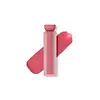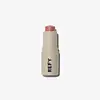Etude House Fixing Tint Bar Versus REFY Lip Blush
What's inside
What's inside
 Key Ingredients
Key Ingredients

 Benefits
Benefits

No benefits
 Concerns
Concerns

 Ingredients Side-by-side
Ingredients Side-by-side

Dicaprylyl Carbonate
EmollientIsododecane
EmollientSynthetic Wax
AbrasiveDimethicone
EmollientTrisiloxane
Skin ConditioningPolymethylsilsesquioxane
CI 77891
Cosmetic ColorantDisteardimonium Hectorite
StabilisingSimmondsia Chinensis Seed Oil
EmollientPolyglyceryl-2 Diisostearate
EmulsifyingPolyglyceryl-2 Triisostearate
EmulsifyingCI 77491
Cosmetic ColorantCeresin
Emulsion StabilisingC30-45 Alkyldimethylsilyl Polypropylsilsesquioxane
CI 15850
Cosmetic ColorantAlumina
AbrasiveCI 15985
Cosmetic ColorantParfum
MaskingCI 77499
Cosmetic ColorantTocopherol
AntioxidantDicaprylyl Carbonate, Isododecane, Synthetic Wax, Dimethicone, Trisiloxane, Polymethylsilsesquioxane, CI 77891, Disteardimonium Hectorite, Simmondsia Chinensis Seed Oil, Polyglyceryl-2 Diisostearate, Polyglyceryl-2 Triisostearate, CI 77491, Ceresin, C30-45 Alkyldimethylsilyl Polypropylsilsesquioxane, CI 15850, Alumina, CI 15985, Parfum, CI 77499, Tocopherol
 Reviews
Reviews

Ingredients Explained
These ingredients are found in both products.
Ingredients higher up in an ingredient list are typically present in a larger amount.
Ci 15850 is the pigment color red. It is an azo dye and created synthetically.
Azo dyes need to be thoroughly purified before use. This allows them to be more stable and longer-lasting.
This ingredient is common in foundations, lipsticks, and blushes. This color is described as brown/orangey red.
It has many secondary names such as Red 6 and Red 7. According to a manufacturer, Red 6 usually contains aluminum.
Learn more about CI 15850Ci 77891 is a white pigment from Titanium dioxide. It is naturally found in minerals such as rutile and ilmenite.
It's main function is to add a white color to cosmetics. It can also be mixed with other colors to create different shades.
Ci 77891 is commonly found in sunscreens due to its ability to block UV rays.
Learn more about CI 77891Dimethicone is a type of synthetic silicone created from natural materials such as quartz.
What it does:
Dimethicone comes in different viscosities:
Depending on the viscosity, dimethicone has different properties.
Ingredients lists don't always show which type is used, so we recommend reaching out to the brand if you have questions about the viscosity.
This ingredient is unlikely to cause irritation because it does not get absorbed into skin. However, people with silicone allergies should be careful about using this ingredient.
Note: Dimethicone may contribute to pilling. This is because it is not oil or water soluble, so pilling may occur when layered with products. When mixed with heavy oils in a formula, the outcome is also quite greasy.
Learn more about DimethiconeDisteardimonium Hectorite comes from the clay mineral named hectorite. It is used to add thickness to a product.
It can also help stabilize a product by helping to disperse other ingredients.
Hectorite is a rare, white clay mineral.
Learn more about Disteardimonium HectoriteSynthetic Wax is created from fossil fuels such as natural gas. It is used to enhance texture, adjust pH, and as an occlusive.
It may also be used as an abrasive ingredient to exfoliate the skin.
Synthetic Wax may not be fungal acne safe.
Learn more about Synthetic Wax